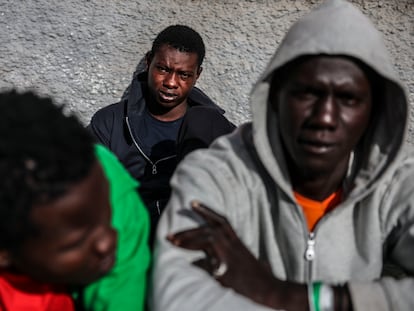Why is there a new surge in migrant boats to Spain’s Canary Islands?
Arrivals have increased by over 50% on the archipelago. El Hierro, with only 11,000 inhabitants, has become the main destination, partly due to unrest in Senegal

Spain’s Canary Islands, located off the northwestern coast of Africa, are once again featuring prominently in the global immigration scene. The increase in arrivals from Africa since the beginning of summer has exceeded all forecasts and records are being posted in October, with up to 1,000 arrivals in a single day. Senegal has been the main departure point in recent months and the small island of El Hierro, the spot with the most arrivals. The figures for 2023 will exceed those of 2020, the second most intense year along this route after 2006, which was the year of the so-called Cayuco Crisis, so named after the type of traditional canoe used by smugglers. But the current scenario is very different from that of three years ago.
What is happening in the Canary Islands?
After a somewhat quieter 2022, the Canary Islands route is once again emerging strongly. Arrivals have grown exponentially since June, coinciding with the social unrest in Senegal, where a two-year prison sentence for opposition leader Ousmane Sonko led to violent protests and several deaths.
Spanish Interior Ministry figures from January to August show arrivals declining by 11.3% compared to the previous year, with a total of 8,508 people. But there was a sharp change in September, and the month ended with more than 6,000 new arrivals, for a nine-month total of 14,976. And October has brought an acceleration of the trend: by October 6, at total of 19,507 people had arrived in the Canary Islands by sea (52% more than the previous year). Adding to this the approximately 1,600 people who have arrived between Sunday and Thursday; so far this month there have already been as many arrivals as in the entire month of September.
The figure is already about to exceed the total for 2022 (22,819 people), and will almost certainly exceed the number for 2020 (23,716 people), the second busiest year since the Canary Islands immigration route was “opened” in 1994. So far, the year 2006 still holds the record, with 31,678 migrant arrivals by sea in the Canary Islands.
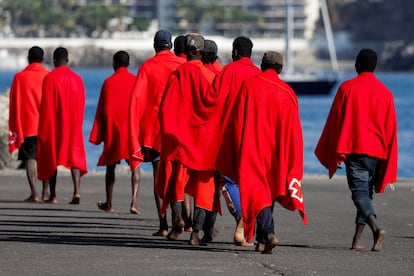
What islands are they reaching?
The small island of El Hierro, with just over 11,400 inhabitants, has become an unexpected destination along this route. Located at the westernmost point of the archipelago, it had received more than 5,000 people to the first week of October, almost half of them in the first week of the month. The records for the entire year, however, place the island of Lanzarote, the closest to the African continent, as the main port of destination, with some 5,300 arrivals. According to official data that is not public, Gran Canaria (4,026), Tenerife (3,169), Fuerteventura (3,169) and La Gomera (36) follow. La Palma and the tiny La Graciosa are the only islands where no migrant boats have arrived.
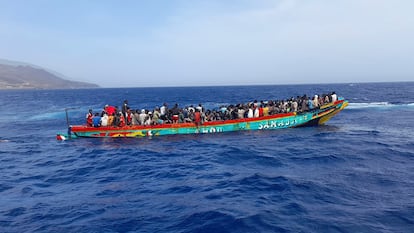
Why do so many cayucos head to El Hierro?
Until recently, the route usually took migrants to the islands of Lanzarote, Gran Canaria or Tenerife, while El Hierro, notwithstanding a few isolated spikes, was a rather exceptional destination. Arrivals here were generally due to the fact that the boat had accidentally gone off course or gotten lost. And indeed, tragedies have occurred near El Hierro, with dozens of people dying aboard drifting canoes, on the verge of being lost in the Atlantic Ocean.
But the pattern seems to have changed. Several sources explained that the boat skippers are now setting a clear course to the island of El Hierro on their GPS navigation systems. This more western trajectory takes Senegalese migrants further from their own coasts, but above all further from the Mauritanian and Moroccan coasts, thus making it more difficult for the security forces of those two countries to intercept them in the middle of their journey.
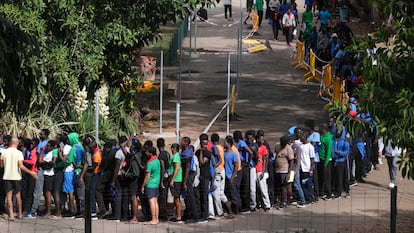
Why has the route been reactivated again?
After the crisis of 2020 and 2021, there was a decrease in activity on the Canary Islands route. The reason was mainly greater collaboration by Moroccan authorities who, after reconciling with Spain in March 2020, worked more diligently to stop the vessels leaving the Saharawi and Moroccan coasts, the main departure points. Now, beyond the good sea conditions, typical of this time of the year, there is a key factor in the rebound: the situation in Senegal.
Since June, the country has been plunged into a political and social crisis that is calling into question the democratic quality of a country until now considered stable. To the structural situation — nearly 40% of its 12.5 million inhabitants live below the poverty line — there is now added social discontent, especially among young people. This unrest has translated into violent protests triggered by President Macky Sall’s attacks against the main opposition leader Ousmane Sonko, a reference for a large section of Senegalese youth. Sonko has been sentenced to prison on charges of calling for insurrection and plotting against the state. His party, the African Patriots of Senegal for Work, Ethics and Fraternity (PASTEF), has been dissolved by decree. The Senegalese youths who are arriving in the Canary Islands report, in addition to economic hardships, repression by the security forces for their political positions.
What is the difference between now and 2020?
A surge in arrivals does not have to be synonymous with a crisis and depends, to a large extent, on how the authorities manage the flow. Some issues are key to differentiating this scenario from that of 2020, which led to a crisis that unleashed social unrest.
A key factor that differentiates one moment from another is the Covid pandemic. The reactivation of the Canary Islands route took place in the midst of the outbreak of the coronavirus. The boats were a way for migrants to escape the economic blockade of their countries, but upon arrival they found a collapsed system. Added to the lack of space to receive new arrivals were the demanding health protocols that required even more resources to guarantee quarantines. In the end, the hotels, empty of tourists, ended up being used as emergency reception centers, with the subsequent social rejection. In 2020 and 2021, not only were there a lack of reception centers and health spaces, but also facilities for the police. More than 2,000 people were crowded into the Gran Canaria port of Arguineguín because the National Police did not have a place to identify and interview the new arrivals. The images of these crowded facilities made world headlines and became a symbol of improvised management.
Another factor to take into account is the way that migrant transfers from the islands to the Spanish mainland have been managed. Of the 20,000 people who arrived, just over 3,000 adults and about 3,300 minors remain on the islands. The rest have already gone to the mainland in transfers organized by the Ministry of Inclusion, Social Security and Migration. Some of those migrants remain in reception centers, while others have moved in with relatives and yet others are on their way to another European country.
This transfer policy was barely applied in 2020 and 2021. The blocking strategy was even applied to migrants who had their passport and enough money to buy a plane ticket out of the islands. With the mobility limitations of the pandemic in place, the Interior Ministry justified a police presence at airports that in practice prevented migrants from getting on a plane, until several court rulings questioned this practice.
The current transfer strategy has taken some strain out of the reception centers, allowing the mobility that migrants seek, and avoiding the kind of protests staged in 2020 by part of the Canary Islands population. Transfers are being made between the islands and the mainland with unusual agility. They are also being done without providing any official data and without any publicity, because the Interior Ministry holds that facilitating the journey to the continent will serve as an incentive for thousands more people to emigrate. The challenge now, however, is how to prevent the reception centers in the Spanish mainland from overflowing, a situation that is already developing.
Finally, there has been a significant rollout of reception centers on the islands in recent years. In 2019, a year that ended with 2,723 arrivals by sea, the Canary Islands did not have even 500 beds for migrants. The chaos that ensued in 2020 led Spanish government officials to announce the so-called Canary Islands Plan on November 20, 2020.
Three years later, there are around 30 facilities operating in the archipelago, especially in Gran Canaria and Tenerife and, to a lesser extent, in Lanzarote and Fuerteventura with a total of 3,500 spots available, which can be doubled if necessary. A good many of these resources are in fact rental apartments and hotels, but there are also large camps, such as those in Las Raíces or Las Canteras, in Tenerife.
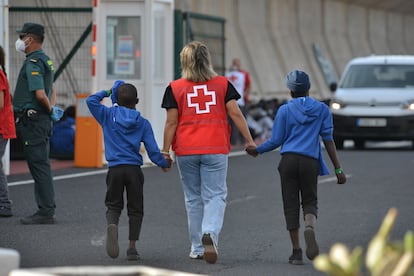
What happens with minors?
Many of the boats that arrive in the Canary Islands carry minors traveling without their parents and whose responsibility and guardianship falls to the regional government. The Canary Islands administration currently has 3,321 children and teenagers in its care, according to an official spokesperson for the regional executive.
In order for them to enter the care system, it is first necessary to confirm that they are under 18 years of age through bone tests, but there are doubts in approximately 50% of cases, according to official sources. Despite the experience of recent years, the system continues to fail and there are adults in juvenile centers and very young children in spaces intended only for adults.
When it is certified that they are minors, these children are integrated into the educational and health system. The Canary Islands government has asked other regions of Spain to show solidarity by agreeing to take some of the minors. But these have not stepped forward, as there are no laws that oblige them to do so. Last year an agreement was reached that the archipelago authorities consider insufficient. The deal involved sending 400 minors to the mainland 2022 and a commitment to transfer another 374 this year.
Sign up for our weekly newsletter to get more English-language news coverage from EL PAÍS USA Edition
Tu suscripción se está usando en otro dispositivo
¿Quieres añadir otro usuario a tu suscripción?
Si continúas leyendo en este dispositivo, no se podrá leer en el otro.
FlechaTu suscripción se está usando en otro dispositivo y solo puedes acceder a EL PAÍS desde un dispositivo a la vez.
Si quieres compartir tu cuenta, cambia tu suscripción a la modalidad Premium, así podrás añadir otro usuario. Cada uno accederá con su propia cuenta de email, lo que os permitirá personalizar vuestra experiencia en EL PAÍS.
¿Tienes una suscripción de empresa? Accede aquí para contratar más cuentas.
En el caso de no saber quién está usando tu cuenta, te recomendamos cambiar tu contraseña aquí.
Si decides continuar compartiendo tu cuenta, este mensaje se mostrará en tu dispositivo y en el de la otra persona que está usando tu cuenta de forma indefinida, afectando a tu experiencia de lectura. Puedes consultar aquí los términos y condiciones de la suscripción digital.
More information
Últimas noticias
Most viewed
- Sinaloa Cartel war is taking its toll on Los Chapitos
- Oona Chaplin: ‘I told James Cameron that I was living in a treehouse and starting a permaculture project with a friend’
- Reinhard Genzel, Nobel laureate in physics: ‘One-minute videos will never give you the truth’
- Why the price of coffee has skyrocketed: from Brazilian plantations to specialty coffee houses
- Silver prices are going crazy: This is what’s fueling the rally
